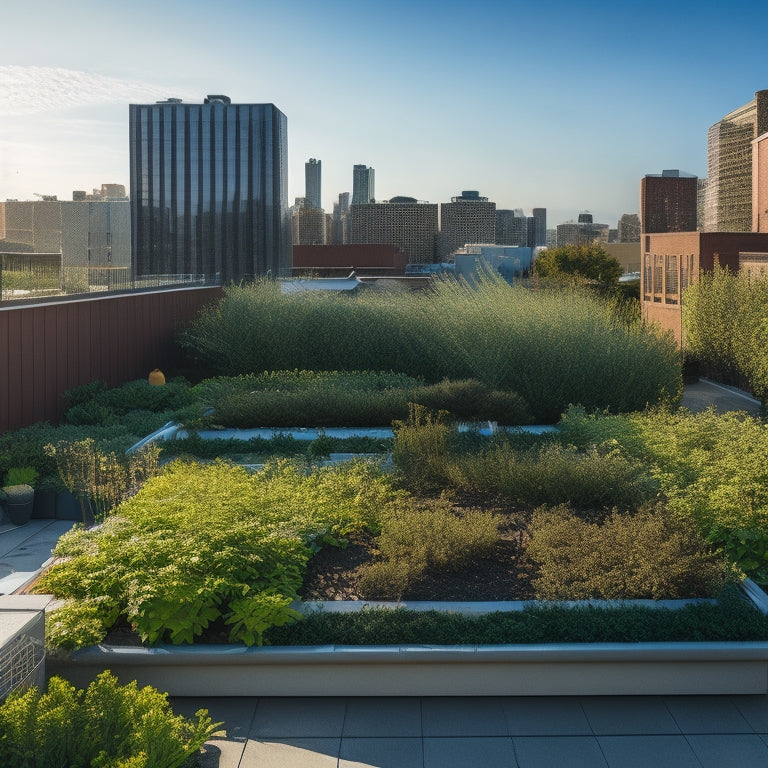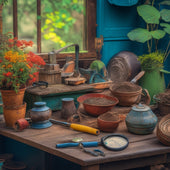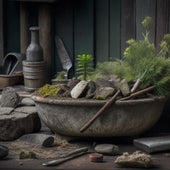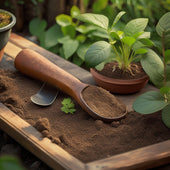
What's the Best Irrigation for Rooftop Herbs?
Share
You'll want an irrigation system that caters to rooftop herbs' unique needs, balancing water delivery with sunlight, drainage, and maintenance requirements. Assess your herbs' water needs, growth habits, and sun exposure to choose the right system. Drip irrigation is a popular choice, as it delivers water directly to roots, reduces evaporation, and minimizes fungal disease risk. Sprinkler systems, on the other hand, provide broader coverage for larger gardens. Consider factors like soil moisture monitoring, timer options, and water conservation strategies to guarantee ideal herb growth. Now, fine-tune your approach to create the perfect rooftop herb garden.
Key Takeaways
• Assess plant water requirements, growth habits, and sun exposure to choose the right irrigation system for rooftop herbs.
• Drip irrigation delivers water directly to roots, ensuring efficient moisture supply and reducing water waste.
• Sprinkler systems provide broader coverage, suitable for larger herb gardens with varying moisture needs and adjustable spray patterns.
• Timers designed for rooftop gardens should withstand harsh outdoor conditions, have adjustable schedules, and remote monitoring capabilities.
• Consider water conservation strategies like rainwater harvesting, mulching, and drought-resistant plants to minimize irrigation demand and waste.
Choosing the Right Irrigation System
When selecting an irrigation system for your rooftop herb garden, consider the specific needs of your plants, including their water requirements, growth habits, and sun exposure. This will help you choose a system that efficiently delivers the right amount of water to each plant.
You'll also want to think about aesthetic considerations, such as the visual appeal of the system and how it will blend in with your rooftop garden's design.
In addition to plant and aesthetic needs, consider the maintenance requirements of the irrigation system. Look for systems with easy-to-clean nozzles and filters to prevent clogging.
You'll also want to choose a system with a user-friendly interface, making it simple to adjust settings and monitor water usage.
Moreover, consider the durability of the system and its resistance to weathering, ensuring it can withstand the outdoor conditions on your rooftop.
Soil Moisture and Drainage Needs
As you plan your rooftop herb irrigation system, you'll need to take into account the soil's water holding capacity to guarantee it can retain the right amount of moisture for your herbs.
You'll also need to think about drainage hole spacing to prevent waterlogged soil, which can be detrimental to your plants' health.
Soil Water Holding Capacity
You need to select a soil mix that balances water holding capacity with drainage to guarantee your rooftop herbs receive the right amount of moisture without waterlogging. This delicate balance is essential, as herbs are sensitive to both drought and waterlogged soil.
To achieve this balance, consider incorporating soil amendments that enhance water retention, such as peat moss or coconut coir. These organic materials can hold up to 20 times their weight in water, slowly releasing it to your herbs as needed. However, be cautious not to overdo it, as excessive water retention can lead to root rot and other problems.
Aim for a mix that retains around 20-30% of its weight in water, allowing for adequate moisture without compromising drainage.
Drainage Hole Spacing Matters
Having selected a well-balanced soil mix, it's now important to guarantee your rooftop herb planters provide adequate drainage to prevent waterlogged soil. This is where strategically spaced drainage holes come into play.
You'll want to ascertain that your planters have sufficient drainage holes to allow excess water to escape, promoting healthy root growth and preventing root rot.
The spacing of these holes is essential, as it directly impacts drainage efficiency. A general rule of thumb is to space drainage holes 1-2 inches apart, depending on the size of your planters and the type of herbs you're growing. This will allow for ideal water flow and prevent water from pooling in the soil.
When it comes to drainage solutions, consider using a planter with built-in drainage or adding a drainage layer, such as perlite or vermiculite, to your soil mix.
Moisture Levels Monitoring
Regularly monitoring moisture levels in your rooftop herb planters is essential to guarantee the best balance between soil moisture and drainage needs. You can't rely on visual inspections alone, as they may not accurately indicate the soil's moisture content.
That's where moisture sensors come in. These devices measure the electrical conductivity of the soil, providing an accurate reading of its moisture levels. By installing moisture sensors in your planters, you'll receive real-time data on the soil's moisture content, enabling you to adjust your irrigation schedule accordingly.
To take it a step further, consider investing in automated monitoring systems that can send alerts to your phone or computer when the soil moisture levels drop below a certain threshold. This way, you'll never miss a watering opportunity, and your herbs will receive the right amount of moisture at the right time.
With automated monitoring, you'll be able to detect any potential issues before they become major problems, ensuring the health and productivity of your rooftop herb garden. By keeping a close eye on soil moisture levels, you'll be able to create a prime growing environment for your herbs to thrive.
Rooftop Herb Garden Watering Tips
As you set up your rooftop herb garden, you'll need to develop a watering strategy that guarantees your herbs receive the right amount of moisture.
To do this, you'll want to regularly check the soil moisture levels to avoid overwatering or underwatering.
Soil Moisture Check
You'll need to check the soil moisture levels of your rooftop herb garden daily, especially during hot and dry weather, to guarantee your herbs receive the right amount of water. This is essential because herbs are sensitive to overwatering, which can lead to root rot and other problems.
To check soil moisture, you can use your finger to feel the top inch of soil. If it feels dry, it's time to water. Alternatively, you can invest in moisture sensors, which provide accurate readings of soil moisture levels.
These sensors are especially useful for rooftop gardens, where soil types may vary and drainage can be a concern. For example, if you have a garden with sandy soil, you may need to water more frequently than one with clay soil.
Watering Schedule Essentials
By pinpointing the ideal watering frequency for your rooftop herb garden, you can strike a balance between hydration and overwatering, ensuring your herbs flourish without succumbing to root rot or other moisture-related issues.
To determine the best watering schedule, consider factors like climate, soil type, and herb growth stage. For instance, young seedlings require more frequent watering than mature plants. As a general rule, water your rooftop herbs when the top 1-2 inches of soil feel dry to the touch.
It's essential to monitor weather conditions, as high temperatures and wind can accelerate evapotranspiration, leading to quicker soil drying. Adjust your watering frequency accordingly, and avoid getting stuck in a rigid schedule.
Instead, inspect your plants daily, looking for signs of stress or waterlogged soil. By doing so, you'll be able to fine-tune your watering schedule to promote healthy herb growth and minimize the risk of overwatering.
Drip Irrigation for Rooftop Herbs
Drip irrigation systems, designed to deliver water directly to the roots of your rooftop herbs, offer a highly efficient and effective way to supply them with the right amount of moisture. This targeted approach guarantees that your herbs receive exactly what they need, when they need it, resulting in ideal growth and flavor.
By using drip irrigation, you can enjoy several benefits that promote healthy herb growth. Here are a few key advantages:
| Drip Irrigation Benefits | Herb Growth Optimization |
|---|---|
| Water Conservation | Reduces evaporation and runoff, guaranteeing every drop counts |
| Reduced Fungal Disease | Prevents water from collecting on leaves, reducing fungal growth |
| Increased Yields | Provides consistent moisture, leading to healthier, more productive plants |
| Less Maintenance | Automates watering, saving you time and effort |
Sprinkler Systems for Herbs
While drip irrigation offers targeted water delivery, sprinkler systems for rooftop herbs provide a broader coverage, making them ideal for larger herb gardens or those with varying soil types and moisture needs.
You'll find that sprinkler systems are particularly useful when you have a mix of herbs with different watering requirements, as they can evenly distribute water across the garden bed.
With a sprinkler system, you can achieve uniform herb growth, which is essential for peak flavor and aroma.
When selecting a sprinkler system, consider the sprinkler coverage area to make certain it matches the size of your rooftop herb garden.
You may also want to opt for a system with adjustable spray patterns to accommodate different herb varieties and layouts.
Additionally, look for sprinklers with built-in filters to prevent clogging and maintain consistent water flow.
Rooftop Irrigation Timer Options
You'll need to select an irrigation timer that's specifically designed for rooftop gardens, as these systems require more frequent watering sessions to account for wind, sun, and heat exposure.
Rooftop irrigation timers must be able to withstand harsh outdoor conditions, including extreme temperatures, humidity, and direct sunlight.
When choosing a timer, consider battery-powered options that can operate independently, even during power outages. These timers are often more reliable and require less maintenance than electric timers.
Smart irrigation timers are another great option, as they can be programmed to adjust watering schedules based on real-time weather data and soil moisture levels. This guarantees your herbs receive the right amount of water, reducing waste and preventing overwatering.
Look for timers with features like remote monitoring, automatic schedule adjustments, and customizable watering programs.
Conserving Water in Rooftop Gardens
Every rooftop herb gardener must prioritize water conservation, as rooftop gardens typically consume more water than traditional gardens due to increased evapotranspiration rates. You can take several steps to reduce your water usage and create a more sustainable rooftop garden. One effective approach is to incorporate drought-resistant plants into your herb selection. These plants are naturally more efficient in their water use, reducing the overall demand on your irrigation system.
| Water Conservation Strategy | Benefits | Implementation Tips |
|---|---|---|
| Rainwater Harvesting | Reduces municipal water usage, decreases stormwater runoff | Install a rainwater collection system, use a first flush device to divert debris |
| Drought-Resistant Plants | Lowers water demand, increases garden resilience | Choose herbs like rosemary, thyme, and oregano, group plants by water needs |
| Mulching | Reduces evapotranspiration, suppresses weed growth | Apply a 2-3 inch layer of organic mulch, replenish as needed |
| Efficient Irrigation | Minimizes water waste, targets plant roots | Use drip irrigation or soaker hoses, schedule watering during cooler hours |
Frequently Asked Questions
Can Rooftop Herbs Be Watered With Collected Rainwater?
You can safely use collected rainwater for rooftop herbs, as long as you implement a proper rainwater harvesting system, following rooftop gardening guidelines, to minimize contamination risks and guarantee water quality.
How Often Should I Inspect My Irrigation System for Damage?
You should inspect your irrigation system regularly for damage, ideally every 2-3 weeks, to assure proper function and prevent leaks, corrosion, or clogs, allowing for timely irrigation maintenance and potential system upgrades to guarantee safe operation.
Are Smart Irrigation Controllers Worth the Investment?
You're maneuvering the complex landscape of irrigation systems, and smart controllers are the GPS guiding you towards efficiency. They're worth the investment, offering benefits like automated schedules and real-time monitoring, which lead to a cost savings analysis that'll make your wallet smile.
Can I Use a Hose With a Drip Irrigation System?
You can definitely use a hose with a drip irrigation system, ensuring drip hose compatibility, but make sure to choose a hose with the right pressure rating to maintain irrigation efficiency and prevent water waste.
Will Wind Affect the Performance of Rooftop Sprinkler Systems?
As you navigate the rooftop garden, remember the sailor battling fierce winds at sea - will your sprinkler system weather the storm? Wind resistance can greatly reduce sprinkler efficiency, so choose a system designed to brave the gusts.
Related Posts
-

5 Must-Knows for Buying Used Tools for Planters
When buying used tools for planters, you're investing in the reliability and performance of your operations, so it's ...
-

5 Must-Knows for Buying Used Tools for Planters
When buying used tools for planters, you're investing in the reliability and performance of your operations, so it's ...
-

5 Must-Knows for Buying Used Tools for Planters
When buying used tools for planters, you're investing in the reliability and performance of your operations, so it's ...
-

5 Must-Knows for Buying Used Tools for Planters
When buying used tools for planters, you're investing in the reliability and performance of your operations, so it's ...
-

5 Must-Knows for Buying Used Tools for Planters
When buying used tools for planters, you're investing in the reliability and performance of your operations, so it's ...
-

5 Must-Knows for Buying Used Tools for Planters
When buying used tools for planters, you're investing in the reliability and performance of your operations, so it's ...
-

5 Must-Knows for Buying Used Tools for Planters
When buying used tools for planters, you're investing in the reliability and performance of your operations, so it's ...
-

5 Must-Knows for Buying Used Tools for Planters
When buying used tools for planters, you're investing in the reliability and performance of your operations, so it's ...
-

5 Must-Knows for Buying Used Tools for Planters
When buying used tools for planters, you're investing in the reliability and performance of your operations, so it's ...
-

5 Must-Knows for Buying Used Tools for Planters
When buying used tools for planters, you're investing in the reliability and performance of your operations, so it's ...
-

5 Must-Knows for Buying Used Tools for Planters
When buying used tools for planters, you're investing in the reliability and performance of your operations, so it's ...
-

5 Must-Knows for Buying Used Tools for Planters
When buying used tools for planters, you're investing in the reliability and performance of your operations, so it's ...
-

5 Must-Knows for Buying Used Tools for Planters
When buying used tools for planters, you're investing in the reliability and performance of your operations, so it's ...
-

5 Must-Knows for Buying Used Tools for Planters
When buying used tools for planters, you're investing in the reliability and performance of your operations, so it's ...
-

5 Must-Knows for Buying Used Tools for Planters
When buying used tools for planters, you're investing in the reliability and performance of your operations, so it's ...
-

5 Must-Knows for Buying Used Tools for Planters
When buying used tools for planters, you're investing in the reliability and performance of your operations, so it's ...
-

5 Must-Knows for Buying Used Tools for Planters
When buying used tools for planters, you're investing in the reliability and performance of your operations, so it's ...
-

5 Must-Knows for Buying Used Tools for Planters
When buying used tools for planters, you're investing in the reliability and performance of your operations, so it's ...
-

5 Must-Knows for Buying Used Tools for Planters
When buying used tools for planters, you're investing in the reliability and performance of your operations, so it's ...
-

5 Must-Knows for Buying Used Tools for Planters
When buying used tools for planters, you're investing in the reliability and performance of your operations, so it's ...
-

What to Know Before Upcycling Concrete Planters
When upcycling concrete planters, you'll want to start by evaluating the planter's size, shape, and condition to guar...
-

What to Know Before Upcycling Concrete Planters
When upcycling concrete planters, you'll want to start by evaluating the planter's size, shape, and condition to guar...
-

What to Know Before Upcycling Concrete Planters
When upcycling concrete planters, you'll want to start by evaluating the planter's size, shape, and condition to guar...
-

What to Know Before Upcycling Concrete Planters
When upcycling concrete planters, you'll want to start by evaluating the planter's size, shape, and condition to guar...
-

What to Know Before Upcycling Concrete Planters
When upcycling concrete planters, you'll want to start by evaluating the planter's size, shape, and condition to guar...
-

What to Know Before Upcycling Concrete Planters
When upcycling concrete planters, you'll want to start by evaluating the planter's size, shape, and condition to guar...
-

What to Know Before Upcycling Concrete Planters
When upcycling concrete planters, you'll want to start by evaluating the planter's size, shape, and condition to guar...
-

What to Know Before Upcycling Concrete Planters
When upcycling concrete planters, you'll want to start by evaluating the planter's size, shape, and condition to guar...
-

What to Know Before Upcycling Concrete Planters
When upcycling concrete planters, you'll want to start by evaluating the planter's size, shape, and condition to guar...
-

What to Know Before Upcycling Concrete Planters
When upcycling concrete planters, you'll want to start by evaluating the planter's size, shape, and condition to guar...
-

What to Know Before Upcycling Concrete Planters
When upcycling concrete planters, you'll want to start by evaluating the planter's size, shape, and condition to guar...
-

What to Know Before Upcycling Concrete Planters
When upcycling concrete planters, you'll want to start by evaluating the planter's size, shape, and condition to guar...
-

What to Know Before Upcycling Concrete Planters
When upcycling concrete planters, you'll want to start by evaluating the planter's size, shape, and condition to guar...
-

What to Know Before Upcycling Concrete Planters
When upcycling concrete planters, you'll want to start by evaluating the planter's size, shape, and condition to guar...
-

What to Know Before Upcycling Concrete Planters
When upcycling concrete planters, you'll want to start by evaluating the planter's size, shape, and condition to guar...
-

What to Know Before Upcycling Concrete Planters
When upcycling concrete planters, you'll want to start by evaluating the planter's size, shape, and condition to guar...
-

What to Know Before Upcycling Concrete Planters
When upcycling concrete planters, you'll want to start by evaluating the planter's size, shape, and condition to guar...
-

What to Know Before Upcycling Concrete Planters
When upcycling concrete planters, you'll want to start by evaluating the planter's size, shape, and condition to guar...
-

What to Know Before Upcycling Concrete Planters
When upcycling concrete planters, you'll want to start by evaluating the planter's size, shape, and condition to guar...
-

What to Know Before Upcycling Concrete Planters
When upcycling concrete planters, you'll want to start by evaluating the planter's size, shape, and condition to guar...
-

What to Know Before Upcycling Concrete Planters
When upcycling concrete planters, you'll want to start by evaluating the planter's size, shape, and condition to guar...
-

What to Know Before Upcycling Concrete Planters
When upcycling concrete planters, you'll want to start by evaluating the planter's size, shape, and condition to guar...
-

What to Know Before Upcycling Concrete Planters
When upcycling concrete planters, you'll want to start by evaluating the planter's size, shape, and condition to guar...
-

What Makes a Good Used Trowel for Planters
When searching for a good used trowel for planters, you'll want to prioritize corrosion-resistant materials like stai...
-

What Makes a Good Used Trowel for Planters
When searching for a good used trowel for planters, you'll want to prioritize corrosion-resistant materials like stai...
-

What Makes a Good Used Trowel for Planters
When searching for a good used trowel for planters, you'll want to prioritize corrosion-resistant materials like stai...
-

What Makes a Good Used Trowel for Planters
When searching for a good used trowel for planters, you'll want to prioritize corrosion-resistant materials like stai...
-

What Makes a Good Used Trowel for Planters
When searching for a good used trowel for planters, you'll want to prioritize corrosion-resistant materials like stai...
-

What Makes a Good Used Trowel for Planters
When searching for a good used trowel for planters, you'll want to prioritize corrosion-resistant materials like stai...
-

What Makes a Good Used Trowel for Planters
When searching for a good used trowel for planters, you'll want to prioritize corrosion-resistant materials like stai...
-

What Makes a Good Used Trowel for Planters
When searching for a good used trowel for planters, you'll want to prioritize corrosion-resistant materials like stai...
-

What Makes a Good Used Trowel for Planters
When searching for a good used trowel for planters, you'll want to prioritize corrosion-resistant materials like stai...
-

What Makes a Good Used Trowel for Planters
When searching for a good used trowel for planters, you'll want to prioritize corrosion-resistant materials like stai...
-

What Makes a Good Used Trowel for Planters
When searching for a good used trowel for planters, you'll want to prioritize corrosion-resistant materials like stai...
-

What Makes a Good Used Trowel for Planters
When searching for a good used trowel for planters, you'll want to prioritize corrosion-resistant materials like stai...
-

What Makes a Good Used Trowel for Planters
When searching for a good used trowel for planters, you'll want to prioritize corrosion-resistant materials like stai...
-

What Makes a Good Used Trowel for Planters
When searching for a good used trowel for planters, you'll want to prioritize corrosion-resistant materials like stai...
-

What Makes a Good Used Trowel for Planters
When searching for a good used trowel for planters, you'll want to prioritize corrosion-resistant materials like stai...
-

What Makes a Good Used Trowel for Planters
When searching for a good used trowel for planters, you'll want to prioritize corrosion-resistant materials like stai...
-

What Makes a Good Used Trowel for Planters
When searching for a good used trowel for planters, you'll want to prioritize corrosion-resistant materials like stai...
-

What Makes a Good Used Trowel for Planters
When searching for a good used trowel for planters, you'll want to prioritize corrosion-resistant materials like stai...
-

What Makes a Good Used Trowel for Planters
When searching for a good used trowel for planters, you'll want to prioritize corrosion-resistant materials like stai...
-

What Makes a Good Used Trowel for Planters
When searching for a good used trowel for planters, you'll want to prioritize corrosion-resistant materials like stai...
-

What Makes a Good Used Trowel for Planters
When searching for a good used trowel for planters, you'll want to prioritize corrosion-resistant materials like stai...
-

What Makes a Good Used Trowel for Planters
When searching for a good used trowel for planters, you'll want to prioritize corrosion-resistant materials like stai...
-

What Makes a Good Used Trowel for Planters
When searching for a good used trowel for planters, you'll want to prioritize corrosion-resistant materials like stai...
-

What Makes a Good Used Trowel for Planters
When searching for a good used trowel for planters, you'll want to prioritize corrosion-resistant materials like stai...


